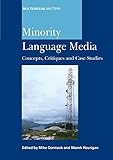Minority Language Media : Concepts, Critiques and Case Studies / ed. by Mike Cormack, Niamh Hourigan.
Material type: TextSeries: Multilingual MattersPublisher: Bristol ; Blue Ridge Summit : Multilingual Matters, [2007]Copyright date: ©2007Description: 1 online resource (232 p.)Content type:
TextSeries: Multilingual MattersPublisher: Bristol ; Blue Ridge Summit : Multilingual Matters, [2007]Copyright date: ©2007Description: 1 online resource (232 p.)Content type: - 9781853599644
- 9781853599651
- 302.23089 22
- P94.5.M55 M56 2007
- P94.5.M55 M56 2007
- online - DeGruyter
| Item type | Current library | Call number | URL | Status | Notes | Barcode | |
|---|---|---|---|---|---|---|---|
 eBook
eBook
|
Biblioteca "Angelicum" Pont. Univ. S.Tommaso d'Aquino Nuvola online | online - DeGruyter (Browse shelf(Opens below)) | Online access | Not for loan (Accesso limitato) | Accesso per gli utenti autorizzati / Access for authorized users | (dgr)9781853599651 |
Frontmatter -- Contents -- Chapter 1. Introduction: Studying Minority Language Media -- Chapter 2. Functional Completeness in Minority Language Media -- Chapter 3. Minority Language Media and the Public Sphere -- Chapter 4. The Media and Language Maintenance -- Chapter 5. The Role of Networks in Minority Language Television Campaigns -- Chapter 6. From Media to Multimedia: Workflows and Language in the Digital Economy -- Chapter 7. Speaking Up: A Brief History of Minority Languages and the Electronic Media1Worldwide -- Chapter 8. Minority Languages and the Internet: New Threats, New Opportunities -- Chapter 9. Linguistic Normalisation and Local Television in the Basque Country -- Chapter 10. Media Policy and Language Policy in Catalonia -- Chapter 11. The Territory of Television: S4C and the Representation of the ‘Whole of Wales’ -- Chapter 12. Translation and Minority Language Media: Potential and Problems: An Irish Perspective -- Chapter 13. Signs of Change: Sign Language and Televisual Media in the UK -- Chapter 14. Minority Language Media Studies: Key Themes for Future Scholarship -- Contributors -- Index
restricted access online access with authorization star
http://purl.org/coar/access_right/c_16ec
Since the founding of television stations in Welsh, Catalan and Basque in the early 1980s, minority languages have gradually gained a new prominence, particularly in Europe. As globalisation has developed, questions concerning such languages and the effect that the media might have on them have become more urgent. This book is the first general study of the many issues raised by this situation. Fourteen researchers from across Europe and the USA examine questions such as the media needs of minority languages, the role of the media in language maintenance, the impact of digital media, and problems raised by translation. Case studies range from the representativeness of drama on Welsh television to Sign Language in the media. Taken as a whole, this book establishes the field of minority language media studies and forms an important basis for future research.
Mode of access: Internet via World Wide Web.
In English.
Description based on online resource; title from PDF title page (publisher's Web site, viewed 01. Dez 2022)


